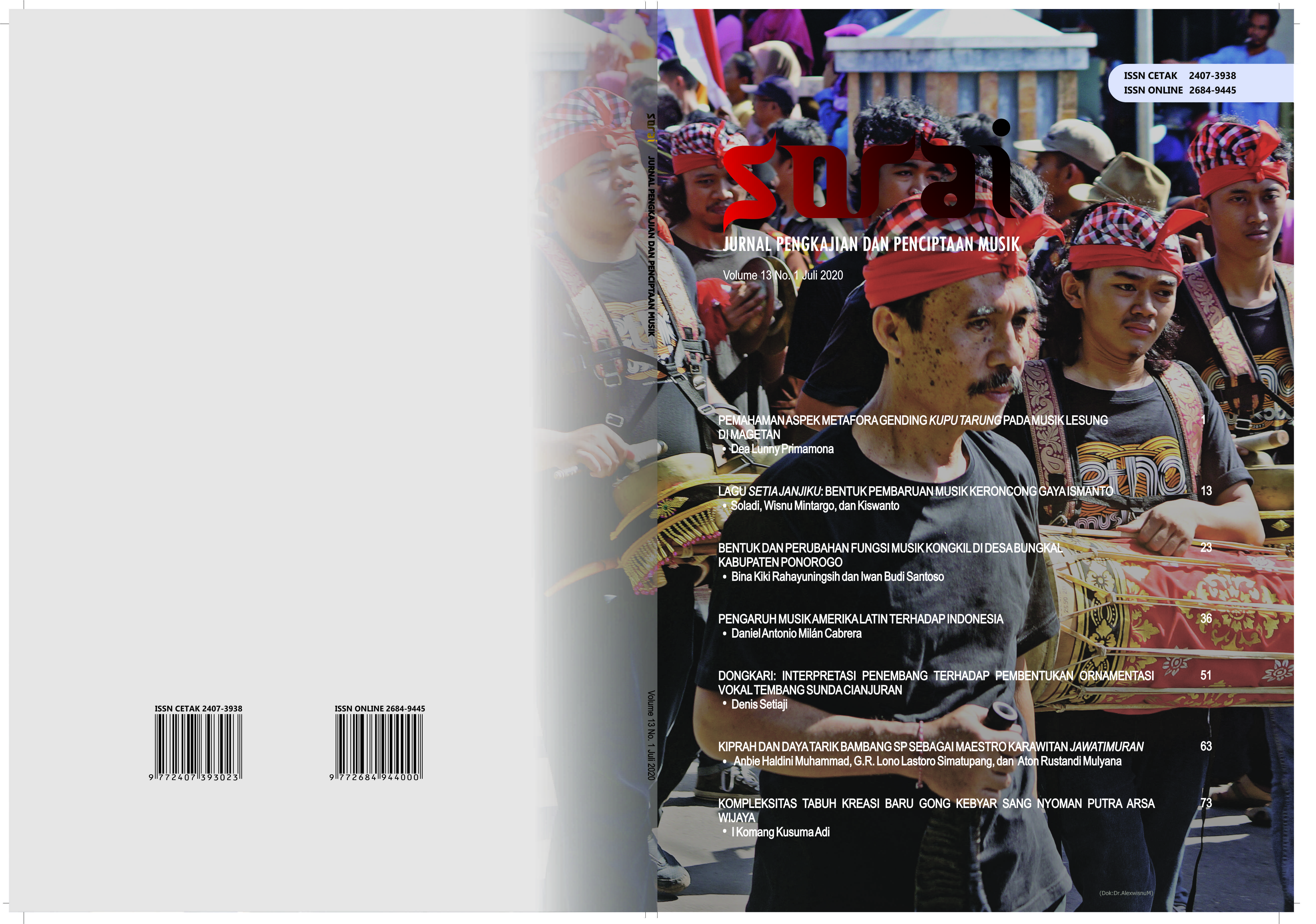BENTUK DAN PERUBAHAN FUNGSI MUSIK KONGKIL DI DESA BUNGKAL KABUPATEN PONOROGO
Main Article Content
Abstract
Kongkil music was created in 1933 by Eyang Toinangun as a means of gathering the people of Bungkal Village as an effort to resist the Dutch invaders. Kongkil music is an ensemble consisting of instruments of kongkil, kedhang, saron, kethuk, kenong, kempul and gong. In the beginning, Kongkil's music brought songs created by its members with the theme of passion-building, because there was no legacy of the old repertoire of the predecessors. There was an innovation in the form of repertoire changes since 1975, namely bringing dolanan gendhing. Around 2000, Kongkil's music was in a vacuum, then it was revived in 2012 with a new repertoire that presented lancaran and langgam gendhing. The research entitled "The Form and Change of Kongkil Music Function in Bungkal Village, Ponorogo Regency" uses the concept of Edy Sedyawati's thought that changes in social structure and values will cause physical changes and the role of art itself in society. It also causes changes in the structure of forms. These changes cannot be avoided if the art is willing to live within the society. This study uses descriptive qualitative analysis methods. From this study, it found several things related to the Kongkil Martapura music group, including: (1) History and regeneration of the Kongkil Martapura music group, (2) the forms of performances, instruments and repertoires presented, (3) the factors driving changes in function and its impact on intellectuals and contextual.
Downloads
Article Details
Copyright
Authors who publish to Sorai: Jurnal Pengkajian dan Penciptaan Musik agrees to the following terms:
- Authors retain copyright and grant the journal right of first publication with the work simultaneously licensed under a Creative Commons Attribution License (CC BY-SA 4.0) that allows others to share the work with an acknowledgment of the work's authorship and initial publication in this journal.
- Authors can enter into separate, additional contractual arrangements for the non-exclusive distribution of the journal's published version of the work (e.g., post it to an institutional repository or edit it in a book), with an acknowledgment of its initial publication in this journal.
- Authors are permitted and encouraged to post their work online (e.g., in institutional repositories or on their website) before and during the submission process, as it can lead to productive exchanges, as well as earlier and greater citation of published work.
References
Brinner, Benjamin.1995. Knowing Music, Making Music: Javannese Gamelan and The Theorynof Music Competence and Interaction. Chicago: The University of Chicago Press.
Getol, Gunadi. 2010. Good LeadershipVs Bad Leadership. Jakarta: Elex Media Komputindo.
Hermawati, Sri. 2008. Seni Budaya Jilid 1 untuk SMK. Jakarta: Direktorat Pembinaan Sekolah Menengah Kejuruan, Direktorat Jenderal Manajemen Pendidikan Dasar dan Menengah, Departemen Pendidikan Nasional.
Hood, Mantle. 1982. The Ethnomusikologist. Ohio: The Kent State Universitity Press.
Kayam, Umar. 1981. Seni, Tradisi, dan Masyarakat. Jakarta: Sinar Harapan.
Koentjaraningrat. 1990. Sejarah Teori Anthropologi II. Jakarta: UI Press.
Merriam, Alan P. 1964. The Antropology of Music, Illionis. North-western: University Press.
Moleong, Lexy J. 2005. Metodologi Penelitian Kualitatif. Bandung: Remaja Rosda Karya.
Mulyana, Aton Rustandi. 2013. “RamP: Estetika Kompleksitas dalam Upacara Ngarot di Lelea Indramayu, Jawa Barat”. Disertasi. Universitas Gadjah Mada, Yogyakarta.
Munandar, Utami. 1999. Kreativitas Dan Keberbakatan. Strategi Mewujudkan Potensi Kreatif Dan Bakat. Jakarta: Gramedia Pustaka Utama.
Nicolas, Arsenio. 2019. Traditional Music and Contemporary Trends. Musik in Asean Communities. Sorai: Jurnal Pengkajian dan Penciptaan Musik.
Nettl, Bruno. 1964. Theory and Method in Ethnomusicology. New York: The Free Press of Glencoe.
Ratna, Nyoman Kutha. 2010. Metodologi Penelitian Kajian Budaya Dan Ilmu Sosial Humaniora Pada Umumnya. Yogyakarta: Pustaka Pelajar Yogyakarta.
Sedyawati, Edy. 1981. Pertumbuhan Seni Pertunjukan. Jakarta: Sinar Harapan.
Simatupang, Lono. 2013.Pergelaran: Sebuah Mozaik Penelitian Seni-Budaya. Yogyakarta: Jalasutra.
Soedarsono, R. M. 2002. Seni Pertunjukan Indonesia di Era Globalisasi. Yogyakarta: Gadjah Mada University Press.
Soekanto, Soerjono. 2009. Sosiologi Suatu Pengantar. Jakarta: PT. Rajawali Press
Supanggah, Rahayu. 2002. Bothekan Karawitan I. Jakarta: Ford Foundation.
Supanggah, Rahayu. 2009. Bothekan Karawitan II: Garap. Surakarta: Program Pascasarjana bekerja sama dengan ISI Press Surakarta.
Turhumawati, Sasana Tunggal. 2008. “Kesenian Reyog Sebagai Daya Tarik Wisata Budaya di Kabupaten Ponorogo.” Laporan Penelitian. Universitas Sebelas Maret Surakarta.
